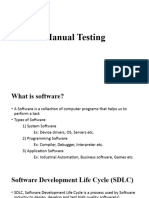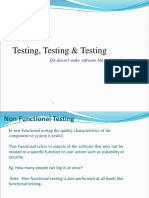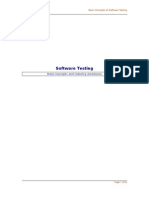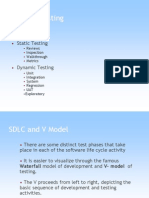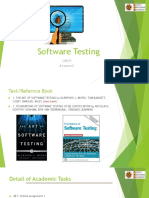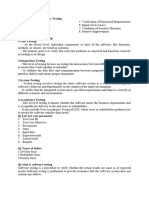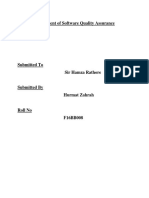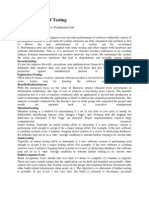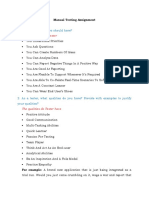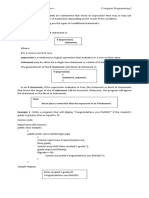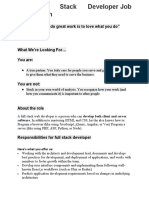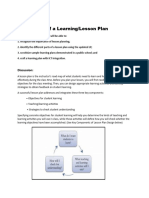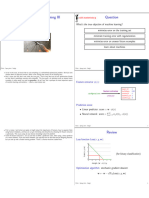Software Quality Assurance
and Testing
Gabriel Kapumpe
School of Computing, Technology and Applied Sciences (SoCTAS)
ZCAS University, 2025
Special Types of Testing
Configuration, Compatibility, GUI, Documentation, and Security Testing
Introduction
Software testing includes various specialized techniques
to ensure functionality, security, and user experience.
• This presentation covers:
- Configuration Testing
- Compatibility Testing
- GUI Testing
- Documentation Testing
- Security Testing
1
�Configuration Testing
• Is a software testing method where an application
is evaluated across different combinations of
hardware and software configurations, including
variations in settings, to ensure it functions
correctly and without errors in various
environments; essentially, testing how the
application behaves under different setup options.
Why is Configuration Testing Important?
• Identifies potential compatibility issues before release.
• Improves software stability across different environments.
2
�Key Aspects of Configuration Testing
1. OS Compatibility
2. Browser Compatibility
3. Network Configurations
4. Hardware Variations
Challenges in Configuration Testing
• Requires
multiple test
environments.
• Can be time-
consuming and
resource-
intensive.
Types of Compatibility Testing
1. Hardware Compatibility
2. OS Compatibility
3. Browser Compatibility
4. Mobile Device Compatibility
3
� Benefits of Compatibility Testing
• Reduces software failures on different environments.
• Enhances user satisfaction by ensuring smooth
performance.
Tools for Compatibility Testing
• Popular tools include BrowserStack, LambdaTest, and CrossBrowserTesting.
What is GUI Testing?
• Ensures that
graphical elements
such as buttons,
menus, and layouts
function correctly
and consistently.
4
�Importance of GUI Testing
• Improves user
experience.
• Ensures UI
elements behave as
expected.
• Validates
responsiveness and
accessibility.
Common GUI Testing Methods
•1. Manual UI Testing
•2. Automated UI Testing using tools like
Selenium
•3. Visual Testing
5
�What is Documentation Testing?
• It is a type of non-functional testing.
• Documentation is any written or pictorial information
describing, defining, specifying, reporting, or certifying
activities, requirements, procedures, or results’.
• Documentation is as important to a product’s success as
the product itself. If the documentation is poor, non-
existent, or wrong, it reflects on the quality of the
product and the vendor.
Types of Documentation Testing
1. User Manuals
2. API Documentation
3. Installation Guides
4. Test Cases and Reports
Why Documentation Testing is Important?
•Prevents user confusion.
•Ensures documentation aligns with
actual software functionality.
6
�Best Practices for Documentation
Testing
1. Keep documentation up-to-date.
2. Validate instructions through usability testing.
3. Ensure clarity and consistency.
What is Security Testing?
•Identifies
vulnerabilities in
software and
ensures data
protection against
threats.
Common Security Testing Techniques
1. Penetration Testing
2. Vulnerability Scanning
3. Risk Assessment
4. Security Audits
7
�Benefits of Security Testing
• Prevents unauthorized access.
• Ensures compliance with security standards.
• Reduces risk of data breaches.
Tools for Security Testing
Summary
• Configuration Testing ensures different system setups
work.
• Compatibility Testing verifies performance across
environments.
• GUI Testing checks usability and UI elements.
• Documentation Testing ensures correctness of manuals.
• Security Testing identifies and fixes security risks.
8
� BREAKFAST
14th March, 2025
GROUP ONE: Exploratory Testing for Mobile
Money Services
• How can exploratory testing be applied to ensure
the reliability and security of mobile money
services, such as those offered by MTN Zambia,
Airtel Zambia, or Zamtel? What role can
exploratory testing play in identifying usability
issues and improving the overall user experience?
9
� GROUP TWO. Cybersecurity Testing for
Zambian Financial Institutions
•What are the cybersecurity testing
challenges faced by Zambian financial
institutions, such as banks and microfinance
institutions? How can security testing be
conducted to ensure compliance with
regulatory requirements, such as those set
by the Bank of Zambia?
GROUP THREE: Agile Testing for E-Government
Services
•How can agile testing be applied to ensure
the timely delivery and quality of e-
government services, such as those offered
by the Zambian Government's Ministry of
National Planning and Development? What
role can automation play in agile testing for
e-government services?
GROUP FOUR: Artificial Intelligence and
Machine Learning Testing for Agriculture
•How can AI and ML testing be applied to
ensure the reliability and accuracy of AI-
powered agricultural systems, such as
those used for crop yield prediction or
disease detection? What role can data
analytics play in improving agricultural
productivity in Zambia
10
�GROUP FIVE: Performance Testing for
Telecommunication Networks
• What are the performance testing challenges
faced by Zambian telecommunication
operators, such as MTN Zambia, Airtel Zambia,
or Zamtel? How can performance testing be
conducted to ensure that telecommunication
networks can handle increased traffic and
provide reliable services?
11
